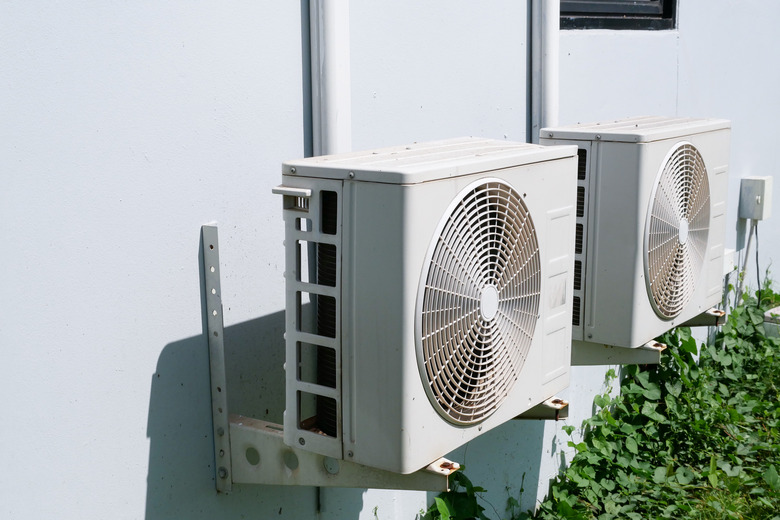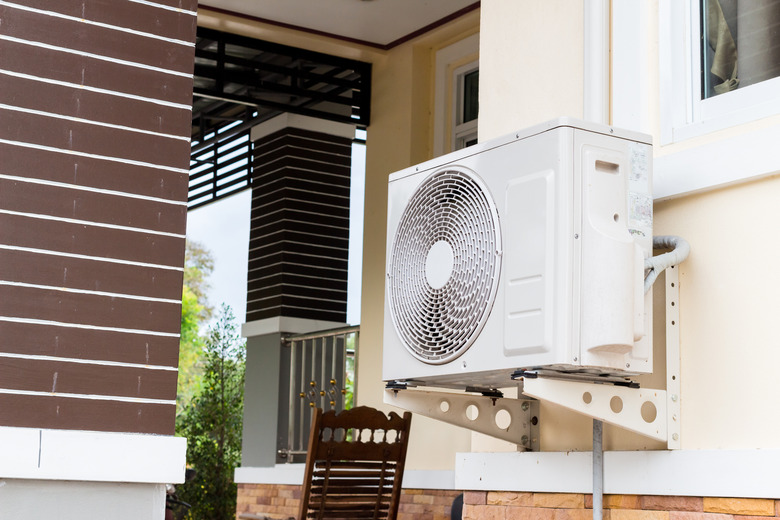What Is A Heat Pump HVAC System?
We may receive a commission on purchases made from links.
If you're familiar with a window air conditioner or even a central air conditioner, you're halfway to understanding what a heat pump does. When it's hot outside and you need cool air indoors, a heat pump works like a standard air conditioner, removing heat from the house and blowing in cold air. When it's cold outside and you need heat, a heat pump reverses its cooling action and blows hot air into the house and exhausts cold air outdoors.
When it comes to energy efficiency, no heating system can top a heat pump system. Unlike combustion furnaces, a heat pump doesn't burn fossil fuels (but it does use electricity, which may be produced by burning fossil fuels), and it consumes 50 percent less electricity than an electric resistive heater. Heat pumps work best in moderate climates where they are often the only heat source in a home, but people also use them in cold climates to provide supplemental heat and to lower their energy bills.
Tip
A heat pump HVAC system is basically a whole-house version of an air conditioner that works with your home's ductwork and has the ability to reverse functions (bringing warm in when it's cold, bringing cool air in when it's hot) by itself.
How a Heat Pump Works
How a Heat Pump Works
HVAC contractors love to mystify their customers by explaining that a heat pump recovers heat from the outside air, an idea that seems impossible if the outside air is cold. The idea isn't as preposterous as it sounds, though, and you can see why if you think about your refrigerator or a standard air conditioner because a heat pump works on the same principle.
A standard refrigeration system consists of a compressor pump and a network of sealed tubing filled with an inert refrigerant that can be repeatedly compressed into a liquid and then vaporized and compressed again. The tubing is formed into two sets of coils known as the condenser coils and the evaporator coils. The compressor's job is to pressurize the refrigerant in the condenser coils, turn it into a liquid and force it through a tiny aperture into the evaporator coils, where it vaporizes and returns to the compressor to begin the cycle again.
Evaporation is an endothermic process, which means that it needs heat to occur, and this heat comes from the surrounding air, which is why the evaporator coils are always cold. Condensation, on the other hand, is a process that releases heat, so the condenser coils are always hot. Instead of exhausting the hot air surrounding the condenser coils as a refrigerator or air conditioner does, a heat pump blows it into the house. The process isn't that mysterious after all.
Types of Heat Pump Systems
Types of Heat Pump Systems
This air-source heat pump system is the most common kind, but it isn't the only one. A water-source system uses water as the medium instead of air and can be an energy-saving option for homeowners who live near a large body of water or who have a well. The evaporator coils are immersed in water, extract heat from it and dissipate the heat through either a sealed indoor water system or, in a water-to-air system, circulate it through HVAC ductwork. In a water-to-water system, heated water can be stored in a tank for use in the bathroom and kitchen or circulated through a hydronic heating system to heat the home.
Instead of extracting heat from the outside air or a body of water, a geothermal heat pump, also known as a ground-source heat pump, takes it from the ground. This type of heat pump takes advantage of the fact that the ground temperature a few feet below the surface is more constant and moderate than that of the surrounding air. This is, in a practical way, a method of harvesting heat energy from the earth and using it for home heating. It's a viable alternative to an air-source heat pump for homeowners in cold climates and is one of the most efficient home heating systems on the market.
Another type of heat pump is known as a ductless, or mini-split, system. It uses the same heating and cooling technology as an air-source heat pump, but instead of circulating heat or cold via air ducts, it uses indoor air handler units (typically mounted high up on interior walls). Mini-splits are most commonly used with apartments or small homes or for supplemental heating and cooling in room additions or remote areas of a larger home, where ductwork is relatively impractical.
Heating and Cooling in One Package
Heating and Cooling in One Package
Because a heat pump is basically an air conditioning system working in reverse, it can also provide cooling if you run it in the "forward" position, which is accomplished by a valve system controlled by the thermostat for the system. When you select the cooling mode on the thermostat, a valve opens to provide a pathway for cool air from the evaporator coils to enter the home, while another valve closes the pathway for warm air from the condenser coils. The opposite happens when you select the heating mode. A thermostat that controls a heat pump has to have a dedicated terminal (designated either O or B) for the reversing valve.
When used in a forced-air HVAC system, the heat pump coils are positioned inside the supply air duct, and warm or cool air is circulated by the blower as needed, while air from the other set of coils is exhausted outdoors. A ductless mini-split system, which looks and acts like a wall-mounted room air conditioner, is connected to an outdoor unit (where the compressor is located) and works the same way as a whole-house system. It can be used to heat and cool individual rooms.
Heat Pump Pros and Cons
Heat Pump Pros and Cons
A heat pump uses electricity, so it isn't a carbon-neutral appliance, but it uses a lot less electricity than a resistive heater. You can even increase the efficiency by installing a dual-source unit that draws heat from both the outside air and the ground. Other advantages include:
- It requires less maintenance than other types of home heating systems. It's almost as easy to maintain as a refrigerator, although the evaporator coils can freeze at times and interfere with the unit's performance, and the air filters need regular service.
- Unlike a combustion furnace, a heat pump can't release toxic combustion gases into the home. It has no appreciable effect on indoor air quality and can even be beneficial because it won't dry out the air the way a furnace does.
- A heat pump can satisfy both heating and cooling needs. In colder climates, it can be coupled with another type of heating system to provide supplemental heat in winter as well as acting as a standalone cooling system in summer.
Heat pumps cost between $800 and $4,500 to purchase depending on size, and installation of a heat pump HVAC system can cost anywhere from $1,200 to $3,500 depending on the amount of ductwork needed. Water- and ground-source heat pumps are more expensive to install, although part of the installation costs may be recouped in lower energy costs because these heat pumps are so energy efficient.
The relatively high cost of a new heat pump isn't the only drawback:
- They don't work everywhere. They are best suited for moderate climates.
- They last about 15 years on average. This isn't as long as gas furnaces, which typically last 20 years or more.
- They use a refrigerant, and so far, no refrigerant has been developed that is 100 percent safe for the environment. If something goes wrong with the refrigeration system, it must by law be serviced by a licensed technician.
- The air from a heat pump HVAC system blows a little colder than that from a furnace, and some people find it uncomfortable.

